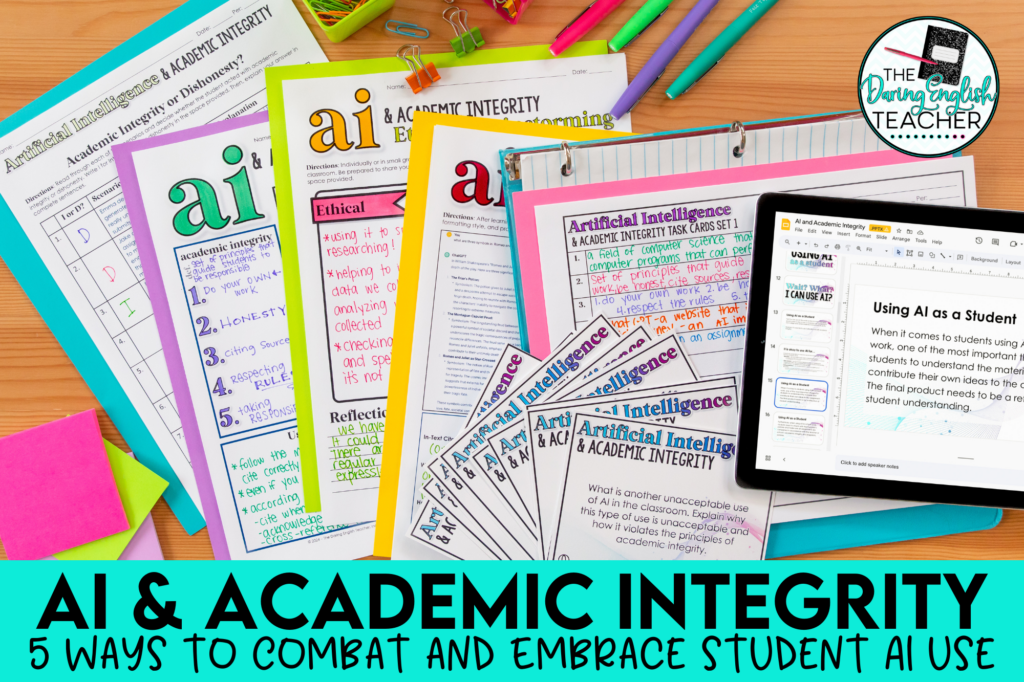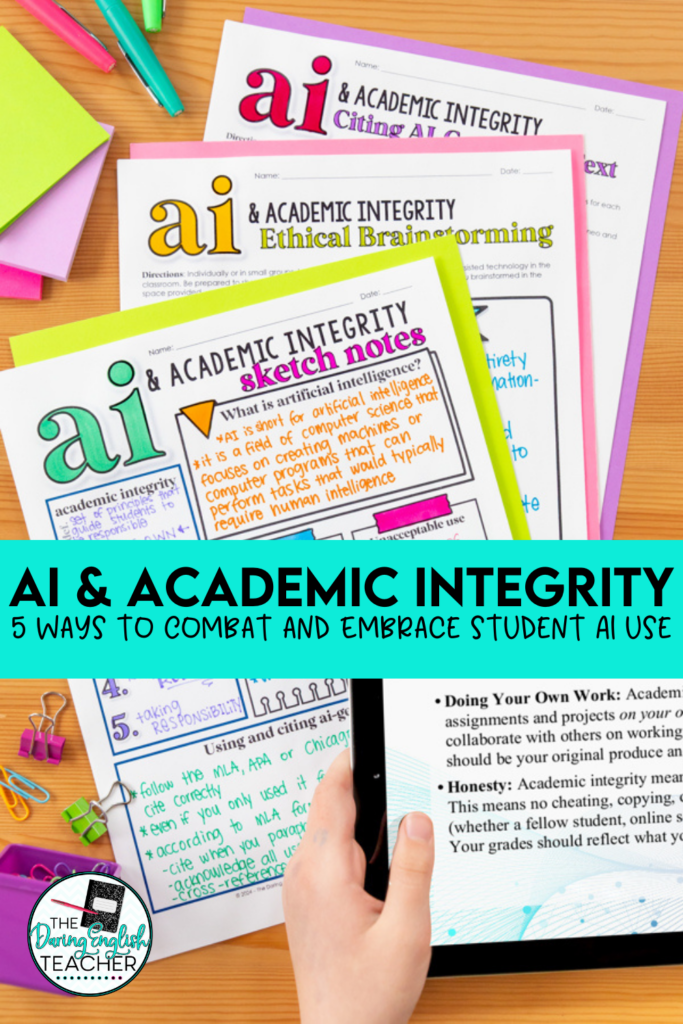
If you are struggling with student artificial intelligent (AI) use in your classroom and you are looking for ways to approach AI and academic integrity in your classroom, you’ve come to the right place! In this blog post, I am going to share five ways teachers can combat and embrace student AI use … because whether we like it or not, AI is here, and it is here to stay. It is just as integrated into their Gen-Z lives as the mixtape was for older millennials.
I vividly remember learning about the release of ChatGPT. I was in awe. I quickly created an account, played around with it, and then did something that sent me into immediate panic. I typed in one of my tried and true essay prompts I use with my high school sophomores, and I immediately went numb watching in disbelief as the screen magically transformed from a blank slate to a rather-decent, but obviously not student-generated, literary analysis essay.
After several unpleasant encounters with students and unethical AI use, I knew I needed to get a handle on the situation and establish ethical ground rules and policies before moving onto another writing unit.
Here are 5 Ways to Combat and Embrace Student AI Use
Focus on Academic Integrity
One of the biggest struggles I am seeing in the classroom with student AI use right now is the lack of academic integrity. And in general, the lack of academic integrity has been increasing each year. I cannot tell you how many times I used to see students copying math homework from a picture on their phone. So many students view “helping their friend” (read: giving them the answers) as truly helping their friend and not dishonest work. That is why focusing on what academic integrity is and isn’t is such an integral component of ethical student AI use.
We need to teach students that their work is supposed to demonstrate to us what they know and don’t know about the subject. We need to emphasize that their work needs to be a reflection of their learning, not some AI-generated or copied and pasted response.
Now, before I begin a writing unit, I take some time to review the instructional slides in this AI teaching unit with my students. It reviews what is and is not academic integrity, along with ethical and unethical ways to use AI.
Know the Signs of Student AI Use

This is a big one. One of the best ways to combat unethical student use of AI-generated text is to know your students and their writing. It is always a good idea to assign a few shorter, in-class writing assignments before diving into a lengthier project. By knowing your students, their writing abilities, their language levels, and their limitations, spotting AI use almost comes second nature.
For many students, the use of a plethora of superfluous words (haha, see what I did there) is a dead giveaway. Another dead giveaway is proper grammar, spelling, and conventions. After you’ve been a teacher for a while and after you’ve read hundreds of essays, you just know common student writing mistakes. You know, they are the same mistakes you point out, show how to correct, and then see again in the next batch of essays.
Knowing your students and how they write is the best way to spot AI use. Online detectors are not accurate enough nor are they reliable enough to catch student AI use at this time.
Have a Solid AI Policy in Place
Why does it always feel like new technology that completely upends the way we teach always happens to launch in the middle of a school year completely catching us off guard? It is a never-ending cycle. Regardless, it is so important to have a solid AI policy and place, and have that policy in your syllabus to make sure that AI and academic integrity are a good fit in your classroom.
I recommend having a specific section for AI and Academic Integrity written into your syllabus. Make sure that students know that student AI use is either not allowed or that it must be properly cited.
Install AI-Detecting Chrome Extensions
While, as of publication date, AI-detection tools and software aren’t reliable enough to accurately detect student AI use, there are two Chrome extensions I use to help monitor and detect AI-generative text in my students’ papers. The first is Draftback and the second is Revision History. While I find that Draftback is helpful, I prefer Revision History because it is more user-friendly.
I only refer to these Chrome extensions if I have a strong suspicion of student AI use. With the Revision History extension, I am able to see a real-time overview of how the document was created, how much of the document was copied and pasted, and how much time the student spent on the document.
Ask Students About Their Work
Above all else, when it comes to AI and academic integrity, it is imperative to keep students in the conversation. One of the best way to detect student AI use, in addition to knowing their writing, is to talk with your students about their writing.
As they are engaging in the writing process, review their brainstorming, outlining, and drafting with them. This will help you get familiar with the content of their writing. Have students submit the entire writing process for a grade. For formal writing, I have students turn in their brainstorming, outlining, and first draft in addition to the final draft.
After students turn in their final drafts, if there is any AI suspicion, ask students about their work. Let them know that the writing they turned in doesn’t match their style and that you’d like them to explain the content and what they wrote about to you. Also, if you notice any high-level vocabulary words, you can ask students to define the words for you.
Usually when I ask students about their work (because I know they didn’t write it), they come clean and admit to their mistakes. When that happens, explain why academic integrity is so important, and I provide students with an opportunity to redo the assignment.
About My AI and Academic Integrity Teaching Unit

Have you struggled with students using AI in the classroom to generate entire essays and other portions of their classwork? Have your students struggled to understand why using AI to complete their assignments might not be entirely academically ethical? Are you at your wit’s end, feeling like you are fighting a never-ending battle against AI use, academic dishonesty, and blatant plagiarism? If so, this print and digital unit is for you!
Like you, I am a classroom teacher also, and ever since the release of ChatGPT, I’ve seen an exponential rise in student AI use in my English classroom. Not only is it frustrating, but it is also infuriating because some students don’t see the harm in using AI. That is why I created this three-day unit!
This unit walks students through the five tenets of academic integrity and what artificial intelligence is. It focuses on how AI use in the classroom either aligns with or goes against academic integrity standards. It also teaches students the proper ways to use AI in the classroom (hint: it is with meticulous citations and clearly stating that AI was used in the assignment). Plus, there is a Google® version of everything so you can customize this unit to fit your needs!
Here’s what you’ll get with this artificial intelligence lesson:
- A three-day unit plan
- All resources on an editable, Google platform
- A teacher guide with suggested tips and help for combating student AI use in the classroom
- A 47-slide editable presentation in PowerPoint and Google Slides®
- A student-teacher AI use contract (that also requires parent/guardian permission)
- Sketchnotes for students to use during instruction
- Ethical brainstorming organizer
- Citing AI-generated text worksheet
- Academic integrity or dishonesty worksheet (same as task card set 2)
- Task card set 1 (general AI and academic integrity info)
- Task card set 2 (same as worksheet above, you choose format)
- Task card recording sheets
- Suggested answer keys
You will love taking charge and feeling more in control in your classroom because you took the time to lay the groundwork for ethical and unethical AI use in your classroom.
After completing this unit, students will have a clear understanding of what AI is and what they can and cannot use AI for in your class. You will have covered all of your bases by teaching students how to properly cite AI-generated text in MLA format and having students research and look up how to do so in APA and Chicago style. Plus, everything is editable, so you can tailor it to your class, school, and district needs!
Also, if you are looking for ways for teachers to use ChatGPT, check out this blog post: 5 Ways for Teachers to Use ChatGPT

